Management Accounting Report, Financial Analysis, and Planning
VerifiedAdded on 2023/01/19
|20
|4451
|23
Report
AI Summary
This report provides a comprehensive overview of management accounting, its role, and various methods, including cost accounting and price optimization. It explores different accounting reports such as performance, budget, accounts receivable, and inventory management reports. The report critically evaluates the integration of management accounting within an organization, emphasizing its benefits and application in companies like AstraZeneca. It delves into the difference between marginal and absorption costing methods, their use in business, and their impact on profit/loss. The report further discusses planning tools, their advantages and disadvantages, and their application in different organizations, including a comparative analysis. It also examines how management accounting responds to financial problems and supports business growth and success through financial reporting and statements. The report concludes by summarizing the key findings and providing relevant references.
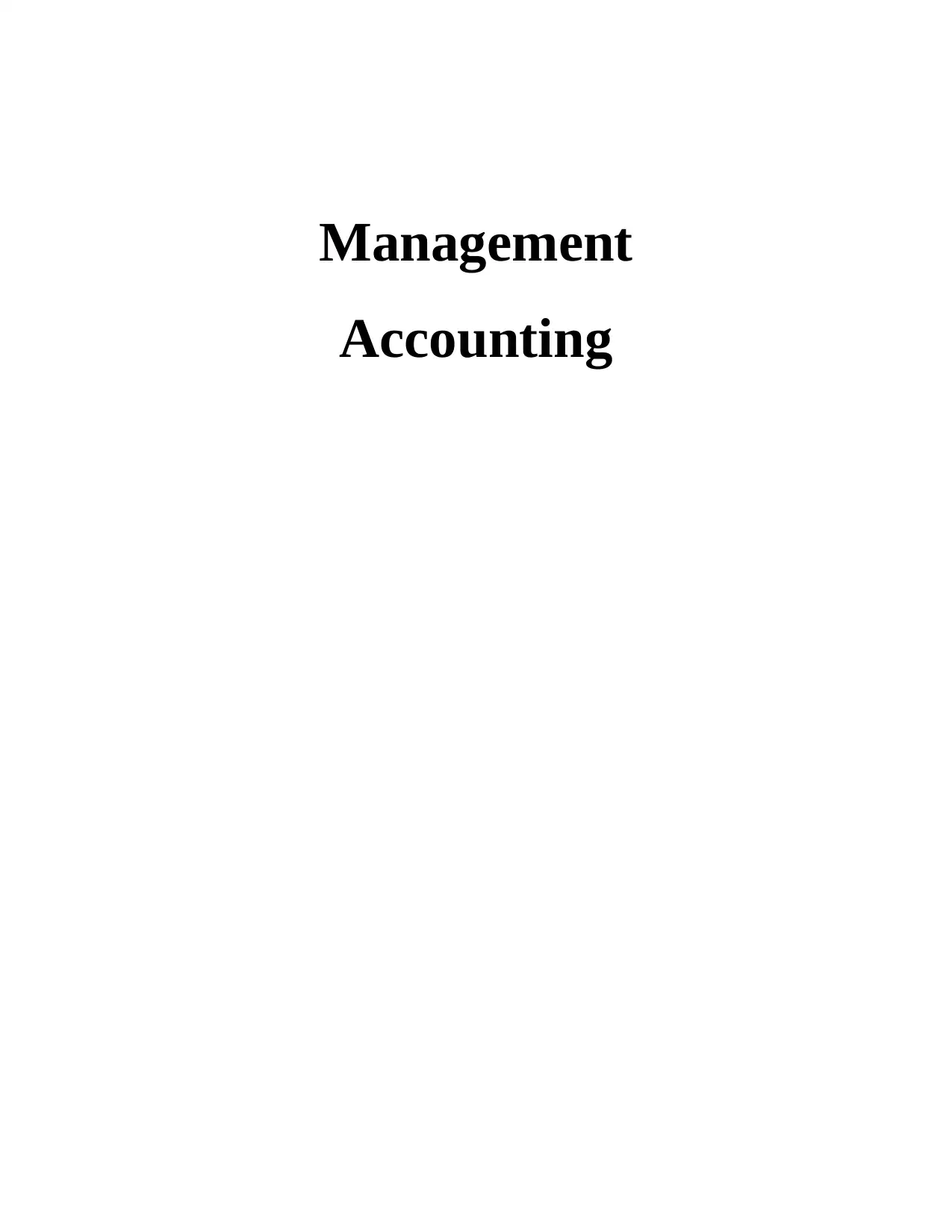
Management
Accounting
Accounting
Paraphrase This Document
Need a fresh take? Get an instant paraphrase of this document with our AI Paraphraser
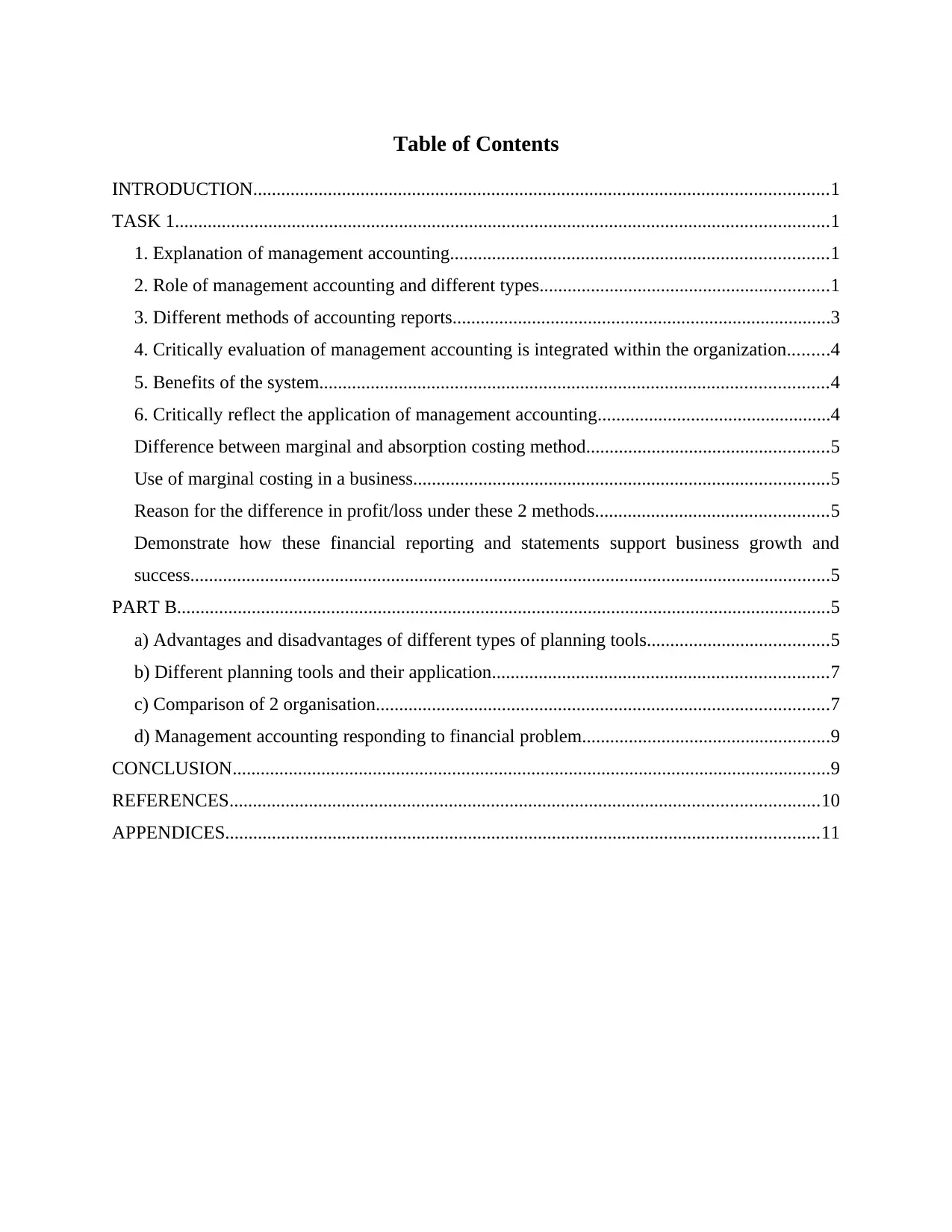
Table of Contents
INTRODUCTION...........................................................................................................................1
TASK 1............................................................................................................................................1
1. Explanation of management accounting.................................................................................1
2. Role of management accounting and different types..............................................................1
3. Different methods of accounting reports.................................................................................3
4. Critically evaluation of management accounting is integrated within the organization.........4
5. Benefits of the system.............................................................................................................4
6. Critically reflect the application of management accounting..................................................4
Difference between marginal and absorption costing method....................................................5
Use of marginal costing in a business.........................................................................................5
Reason for the difference in profit/loss under these 2 methods..................................................5
Demonstrate how these financial reporting and statements support business growth and
success.........................................................................................................................................5
PART B............................................................................................................................................5
a) Advantages and disadvantages of different types of planning tools.......................................5
b) Different planning tools and their application........................................................................7
c) Comparison of 2 organisation.................................................................................................7
d) Management accounting responding to financial problem.....................................................9
CONCLUSION................................................................................................................................9
REFERENCES..............................................................................................................................10
APPENDICES...............................................................................................................................11
INTRODUCTION...........................................................................................................................1
TASK 1............................................................................................................................................1
1. Explanation of management accounting.................................................................................1
2. Role of management accounting and different types..............................................................1
3. Different methods of accounting reports.................................................................................3
4. Critically evaluation of management accounting is integrated within the organization.........4
5. Benefits of the system.............................................................................................................4
6. Critically reflect the application of management accounting..................................................4
Difference between marginal and absorption costing method....................................................5
Use of marginal costing in a business.........................................................................................5
Reason for the difference in profit/loss under these 2 methods..................................................5
Demonstrate how these financial reporting and statements support business growth and
success.........................................................................................................................................5
PART B............................................................................................................................................5
a) Advantages and disadvantages of different types of planning tools.......................................5
b) Different planning tools and their application........................................................................7
c) Comparison of 2 organisation.................................................................................................7
d) Management accounting responding to financial problem.....................................................9
CONCLUSION................................................................................................................................9
REFERENCES..............................................................................................................................10
APPENDICES...............................................................................................................................11
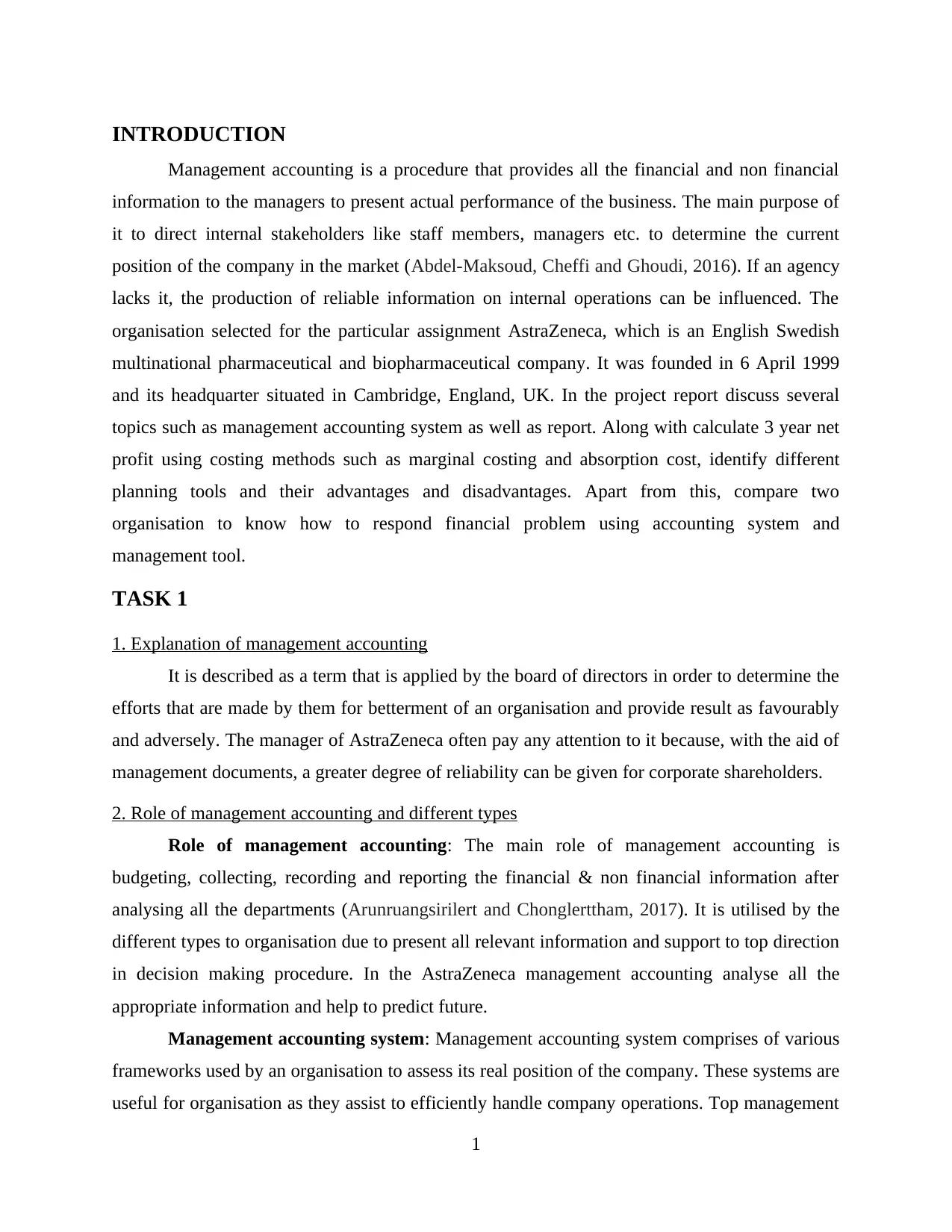
INTRODUCTION
Management accounting is a procedure that provides all the financial and non financial
information to the managers to present actual performance of the business. The main purpose of
it to direct internal stakeholders like staff members, managers etc. to determine the current
position of the company in the market (Abdel-Maksoud, Cheffi and Ghoudi, 2016). If an agency
lacks it, the production of reliable information on internal operations can be influenced. The
organisation selected for the particular assignment AstraZeneca, which is an English Swedish
multinational pharmaceutical and biopharmaceutical company. It was founded in 6 April 1999
and its headquarter situated in Cambridge, England, UK. In the project report discuss several
topics such as management accounting system as well as report. Along with calculate 3 year net
profit using costing methods such as marginal costing and absorption cost, identify different
planning tools and their advantages and disadvantages. Apart from this, compare two
organisation to know how to respond financial problem using accounting system and
management tool.
TASK 1
1. Explanation of management accounting
It is described as a term that is applied by the board of directors in order to determine the
efforts that are made by them for betterment of an organisation and provide result as favourably
and adversely. The manager of AstraZeneca often pay any attention to it because, with the aid of
management documents, a greater degree of reliability can be given for corporate shareholders.
2. Role of management accounting and different types
Role of management accounting: The main role of management accounting is
budgeting, collecting, recording and reporting the financial & non financial information after
analysing all the departments (Arunruangsirilert and Chonglerttham, 2017). It is utilised by the
different types to organisation due to present all relevant information and support to top direction
in decision making procedure. In the AstraZeneca management accounting analyse all the
appropriate information and help to predict future.
Management accounting system: Management accounting system comprises of various
frameworks used by an organisation to assess its real position of the company. These systems are
useful for organisation as they assist to efficiently handle company operations. Top management
1
Management accounting is a procedure that provides all the financial and non financial
information to the managers to present actual performance of the business. The main purpose of
it to direct internal stakeholders like staff members, managers etc. to determine the current
position of the company in the market (Abdel-Maksoud, Cheffi and Ghoudi, 2016). If an agency
lacks it, the production of reliable information on internal operations can be influenced. The
organisation selected for the particular assignment AstraZeneca, which is an English Swedish
multinational pharmaceutical and biopharmaceutical company. It was founded in 6 April 1999
and its headquarter situated in Cambridge, England, UK. In the project report discuss several
topics such as management accounting system as well as report. Along with calculate 3 year net
profit using costing methods such as marginal costing and absorption cost, identify different
planning tools and their advantages and disadvantages. Apart from this, compare two
organisation to know how to respond financial problem using accounting system and
management tool.
TASK 1
1. Explanation of management accounting
It is described as a term that is applied by the board of directors in order to determine the
efforts that are made by them for betterment of an organisation and provide result as favourably
and adversely. The manager of AstraZeneca often pay any attention to it because, with the aid of
management documents, a greater degree of reliability can be given for corporate shareholders.
2. Role of management accounting and different types
Role of management accounting: The main role of management accounting is
budgeting, collecting, recording and reporting the financial & non financial information after
analysing all the departments (Arunruangsirilert and Chonglerttham, 2017). It is utilised by the
different types to organisation due to present all relevant information and support to top direction
in decision making procedure. In the AstraZeneca management accounting analyse all the
appropriate information and help to predict future.
Management accounting system: Management accounting system comprises of various
frameworks used by an organisation to assess its real position of the company. These systems are
useful for organisation as they assist to efficiently handle company operations. Top management
1
⊘ This is a preview!⊘
Do you want full access?
Subscribe today to unlock all pages.

Trusted by 1+ million students worldwide
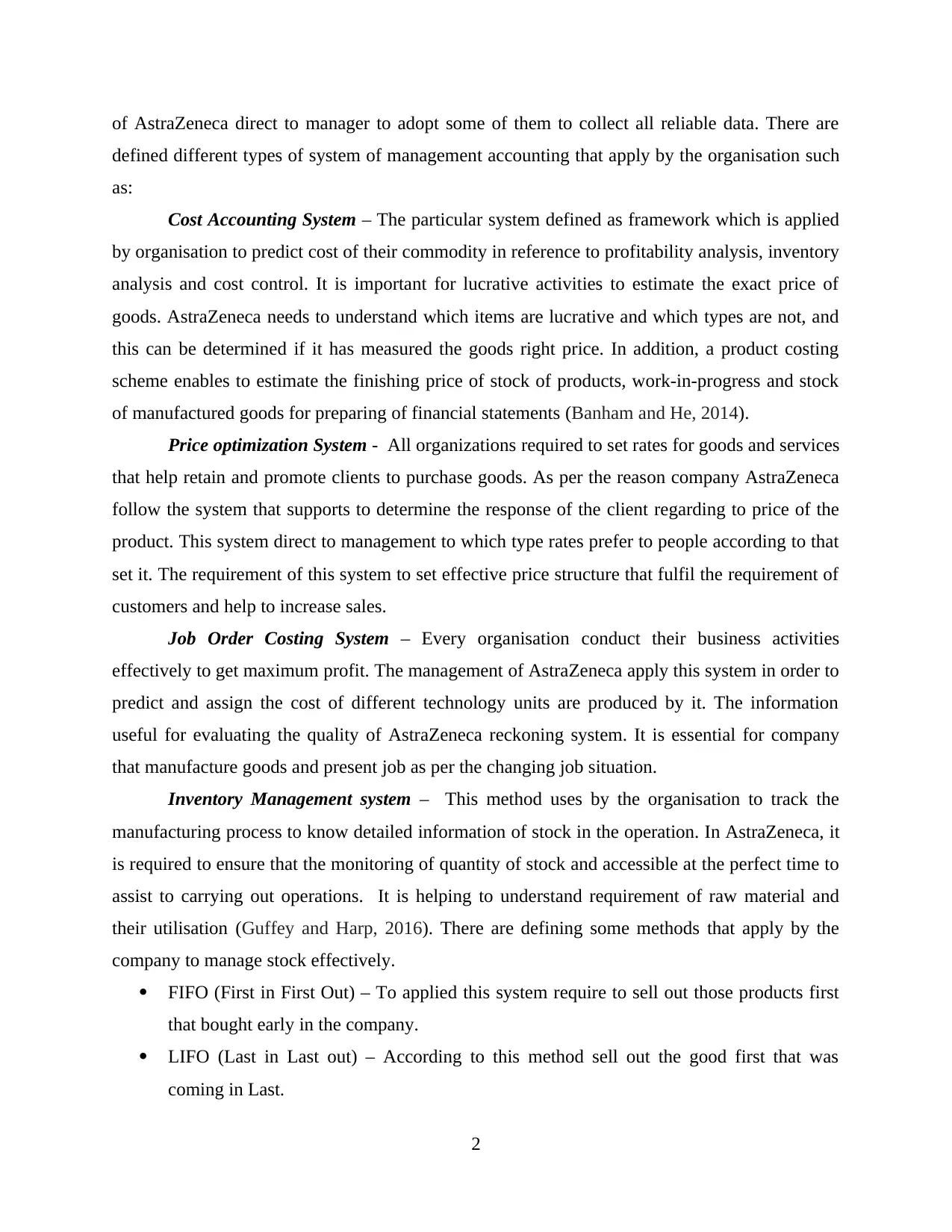
of AstraZeneca direct to manager to adopt some of them to collect all reliable data. There are
defined different types of system of management accounting that apply by the organisation such
as:
Cost Accounting System – The particular system defined as framework which is applied
by organisation to predict cost of their commodity in reference to profitability analysis, inventory
analysis and cost control. It is important for lucrative activities to estimate the exact price of
goods. AstraZeneca needs to understand which items are lucrative and which types are not, and
this can be determined if it has measured the goods right price. In addition, a product costing
scheme enables to estimate the finishing price of stock of products, work-in-progress and stock
of manufactured goods for preparing of financial statements (Banham and He, 2014).
Price optimization System - All organizations required to set rates for goods and services
that help retain and promote clients to purchase goods. As per the reason company AstraZeneca
follow the system that supports to determine the response of the client regarding to price of the
product. This system direct to management to which type rates prefer to people according to that
set it. The requirement of this system to set effective price structure that fulfil the requirement of
customers and help to increase sales.
Job Order Costing System – Every organisation conduct their business activities
effectively to get maximum profit. The management of AstraZeneca apply this system in order to
predict and assign the cost of different technology units are produced by it. The information
useful for evaluating the quality of AstraZeneca reckoning system. It is essential for company
that manufacture goods and present job as per the changing job situation.
Inventory Management system – This method uses by the organisation to track the
manufacturing process to know detailed information of stock in the operation. In AstraZeneca, it
is required to ensure that the monitoring of quantity of stock and accessible at the perfect time to
assist to carrying out operations. It is helping to understand requirement of raw material and
their utilisation (Guffey and Harp, 2016). There are defining some methods that apply by the
company to manage stock effectively.
FIFO (First in First Out) – To applied this system require to sell out those products first
that bought early in the company.
LIFO (Last in Last out) – According to this method sell out the good first that was
coming in Last.
2
defined different types of system of management accounting that apply by the organisation such
as:
Cost Accounting System – The particular system defined as framework which is applied
by organisation to predict cost of their commodity in reference to profitability analysis, inventory
analysis and cost control. It is important for lucrative activities to estimate the exact price of
goods. AstraZeneca needs to understand which items are lucrative and which types are not, and
this can be determined if it has measured the goods right price. In addition, a product costing
scheme enables to estimate the finishing price of stock of products, work-in-progress and stock
of manufactured goods for preparing of financial statements (Banham and He, 2014).
Price optimization System - All organizations required to set rates for goods and services
that help retain and promote clients to purchase goods. As per the reason company AstraZeneca
follow the system that supports to determine the response of the client regarding to price of the
product. This system direct to management to which type rates prefer to people according to that
set it. The requirement of this system to set effective price structure that fulfil the requirement of
customers and help to increase sales.
Job Order Costing System – Every organisation conduct their business activities
effectively to get maximum profit. The management of AstraZeneca apply this system in order to
predict and assign the cost of different technology units are produced by it. The information
useful for evaluating the quality of AstraZeneca reckoning system. It is essential for company
that manufacture goods and present job as per the changing job situation.
Inventory Management system – This method uses by the organisation to track the
manufacturing process to know detailed information of stock in the operation. In AstraZeneca, it
is required to ensure that the monitoring of quantity of stock and accessible at the perfect time to
assist to carrying out operations. It is helping to understand requirement of raw material and
their utilisation (Guffey and Harp, 2016). There are defining some methods that apply by the
company to manage stock effectively.
FIFO (First in First Out) – To applied this system require to sell out those products first
that bought early in the company.
LIFO (Last in Last out) – According to this method sell out the good first that was
coming in Last.
2
Paraphrase This Document
Need a fresh take? Get an instant paraphrase of this document with our AI Paraphraser
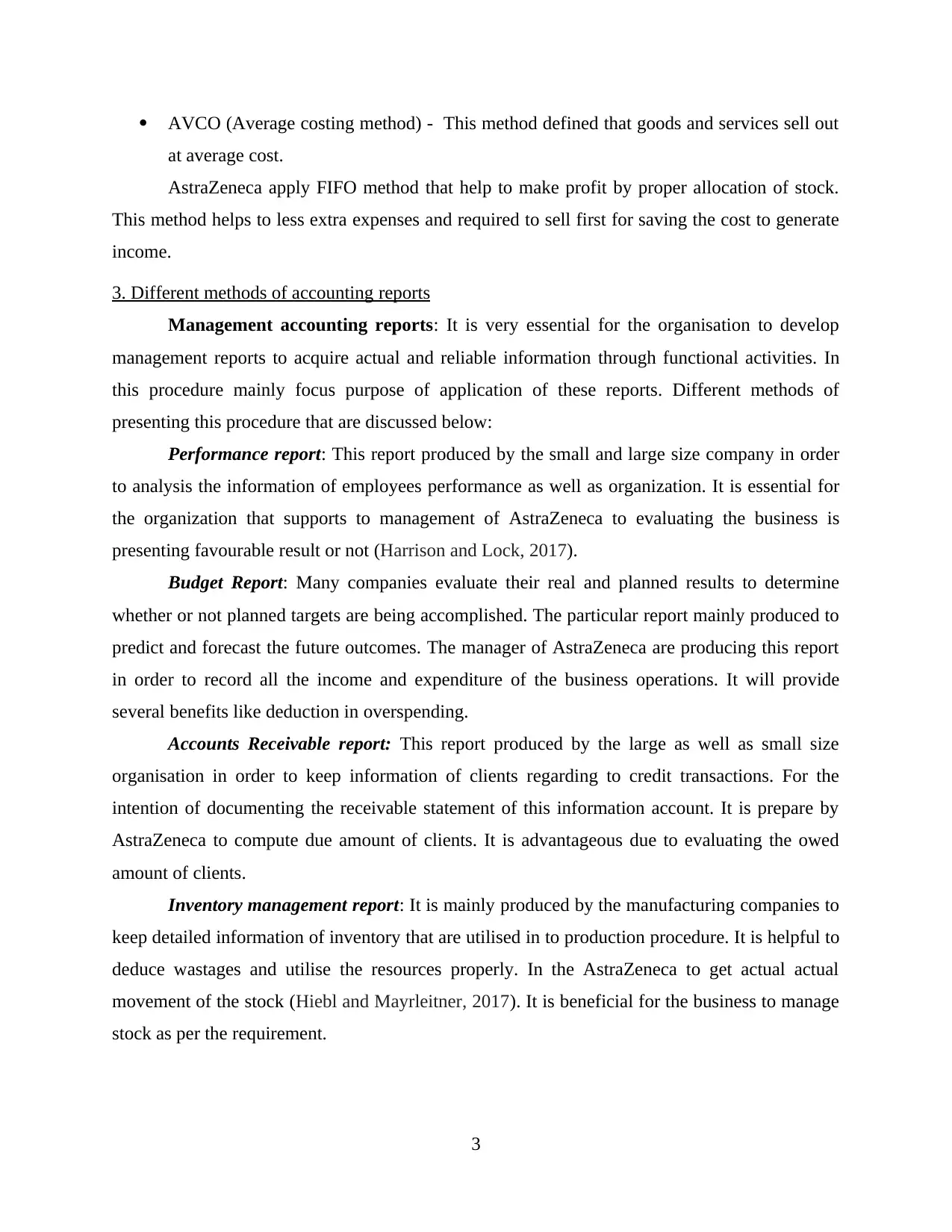
AVCO (Average costing method) - This method defined that goods and services sell out
at average cost.
AstraZeneca apply FIFO method that help to make profit by proper allocation of stock.
This method helps to less extra expenses and required to sell first for saving the cost to generate
income.
3. Different methods of accounting reports
Management accounting reports: It is very essential for the organisation to develop
management reports to acquire actual and reliable information through functional activities. In
this procedure mainly focus purpose of application of these reports. Different methods of
presenting this procedure that are discussed below:
Performance report: This report produced by the small and large size company in order
to analysis the information of employees performance as well as organization. It is essential for
the organization that supports to management of AstraZeneca to evaluating the business is
presenting favourable result or not (Harrison and Lock, 2017).
Budget Report: Many companies evaluate their real and planned results to determine
whether or not planned targets are being accomplished. The particular report mainly produced to
predict and forecast the future outcomes. The manager of AstraZeneca are producing this report
in order to record all the income and expenditure of the business operations. It will provide
several benefits like deduction in overspending.
Accounts Receivable report: This report produced by the large as well as small size
organisation in order to keep information of clients regarding to credit transactions. For the
intention of documenting the receivable statement of this information account. It is prepare by
AstraZeneca to compute due amount of clients. It is advantageous due to evaluating the owed
amount of clients.
Inventory management report: It is mainly produced by the manufacturing companies to
keep detailed information of inventory that are utilised in to production procedure. It is helpful to
deduce wastages and utilise the resources properly. In the AstraZeneca to get actual actual
movement of the stock (Hiebl and Mayrleitner, 2017). It is beneficial for the business to manage
stock as per the requirement.
3
at average cost.
AstraZeneca apply FIFO method that help to make profit by proper allocation of stock.
This method helps to less extra expenses and required to sell first for saving the cost to generate
income.
3. Different methods of accounting reports
Management accounting reports: It is very essential for the organisation to develop
management reports to acquire actual and reliable information through functional activities. In
this procedure mainly focus purpose of application of these reports. Different methods of
presenting this procedure that are discussed below:
Performance report: This report produced by the small and large size company in order
to analysis the information of employees performance as well as organization. It is essential for
the organization that supports to management of AstraZeneca to evaluating the business is
presenting favourable result or not (Harrison and Lock, 2017).
Budget Report: Many companies evaluate their real and planned results to determine
whether or not planned targets are being accomplished. The particular report mainly produced to
predict and forecast the future outcomes. The manager of AstraZeneca are producing this report
in order to record all the income and expenditure of the business operations. It will provide
several benefits like deduction in overspending.
Accounts Receivable report: This report produced by the large as well as small size
organisation in order to keep information of clients regarding to credit transactions. For the
intention of documenting the receivable statement of this information account. It is prepare by
AstraZeneca to compute due amount of clients. It is advantageous due to evaluating the owed
amount of clients.
Inventory management report: It is mainly produced by the manufacturing companies to
keep detailed information of inventory that are utilised in to production procedure. It is helpful to
deduce wastages and utilise the resources properly. In the AstraZeneca to get actual actual
movement of the stock (Hiebl and Mayrleitner, 2017). It is beneficial for the business to manage
stock as per the requirement.
3
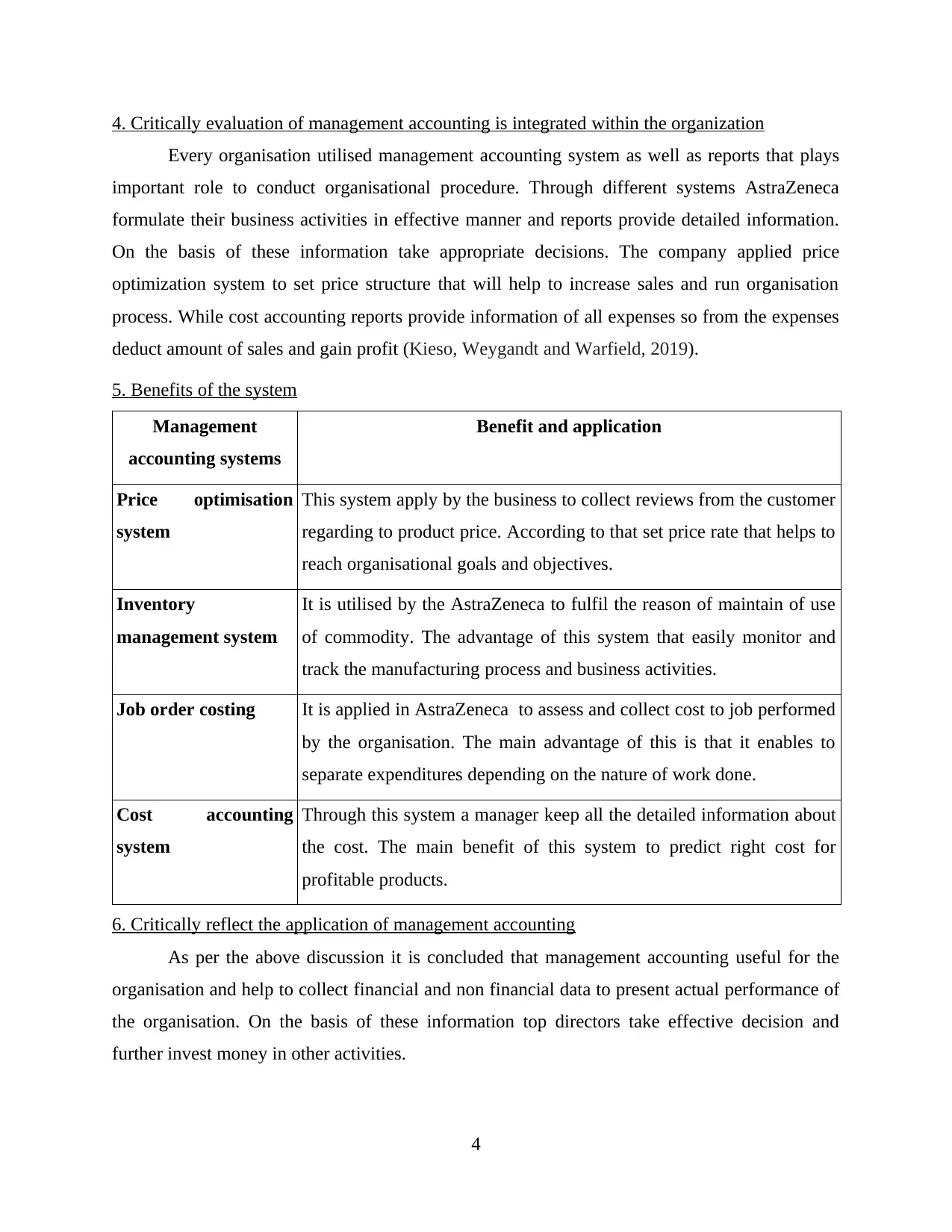
4. Critically evaluation of management accounting is integrated within the organization
Every organisation utilised management accounting system as well as reports that plays
important role to conduct organisational procedure. Through different systems AstraZeneca
formulate their business activities in effective manner and reports provide detailed information.
On the basis of these information take appropriate decisions. The company applied price
optimization system to set price structure that will help to increase sales and run organisation
process. While cost accounting reports provide information of all expenses so from the expenses
deduct amount of sales and gain profit (Kieso, Weygandt and Warfield, 2019).
5. Benefits of the system
Management
accounting systems
Benefit and application
Price optimisation
system
This system apply by the business to collect reviews from the customer
regarding to product price. According to that set price rate that helps to
reach organisational goals and objectives.
Inventory
management system
It is utilised by the AstraZeneca to fulfil the reason of maintain of use
of commodity. The advantage of this system that easily monitor and
track the manufacturing process and business activities.
Job order costing It is applied in AstraZeneca to assess and collect cost to job performed
by the organisation. The main advantage of this is that it enables to
separate expenditures depending on the nature of work done.
Cost accounting
system
Through this system a manager keep all the detailed information about
the cost. The main benefit of this system to predict right cost for
profitable products.
6. Critically reflect the application of management accounting
As per the above discussion it is concluded that management accounting useful for the
organisation and help to collect financial and non financial data to present actual performance of
the organisation. On the basis of these information top directors take effective decision and
further invest money in other activities.
4
Every organisation utilised management accounting system as well as reports that plays
important role to conduct organisational procedure. Through different systems AstraZeneca
formulate their business activities in effective manner and reports provide detailed information.
On the basis of these information take appropriate decisions. The company applied price
optimization system to set price structure that will help to increase sales and run organisation
process. While cost accounting reports provide information of all expenses so from the expenses
deduct amount of sales and gain profit (Kieso, Weygandt and Warfield, 2019).
5. Benefits of the system
Management
accounting systems
Benefit and application
Price optimisation
system
This system apply by the business to collect reviews from the customer
regarding to product price. According to that set price rate that helps to
reach organisational goals and objectives.
Inventory
management system
It is utilised by the AstraZeneca to fulfil the reason of maintain of use
of commodity. The advantage of this system that easily monitor and
track the manufacturing process and business activities.
Job order costing It is applied in AstraZeneca to assess and collect cost to job performed
by the organisation. The main advantage of this is that it enables to
separate expenditures depending on the nature of work done.
Cost accounting
system
Through this system a manager keep all the detailed information about
the cost. The main benefit of this system to predict right cost for
profitable products.
6. Critically reflect the application of management accounting
As per the above discussion it is concluded that management accounting useful for the
organisation and help to collect financial and non financial data to present actual performance of
the organisation. On the basis of these information top directors take effective decision and
further invest money in other activities.
4
⊘ This is a preview!⊘
Do you want full access?
Subscribe today to unlock all pages.

Trusted by 1+ million students worldwide
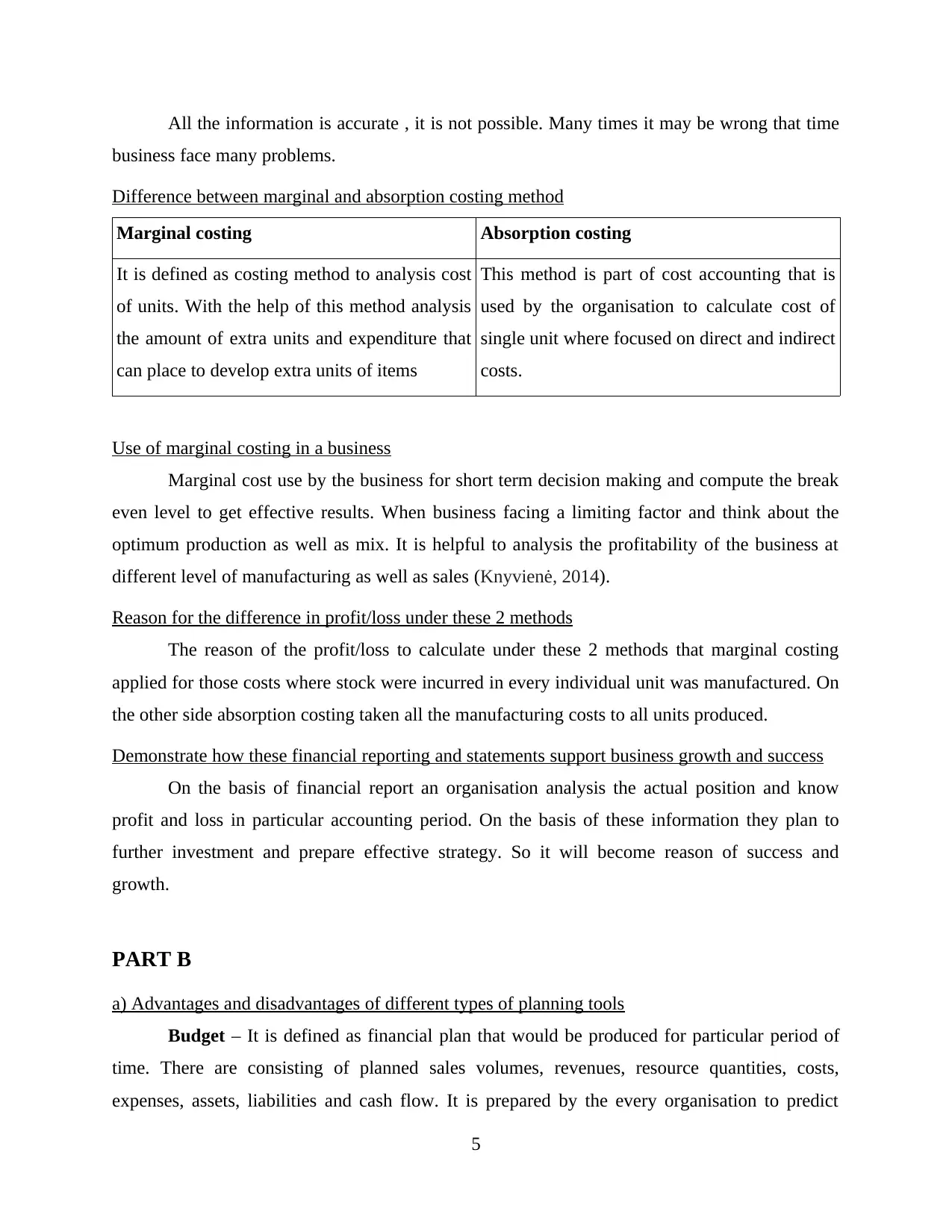
All the information is accurate , it is not possible. Many times it may be wrong that time
business face many problems.
Difference between marginal and absorption costing method
Marginal costing Absorption costing
It is defined as costing method to analysis cost
of units. With the help of this method analysis
the amount of extra units and expenditure that
can place to develop extra units of items
This method is part of cost accounting that is
used by the organisation to calculate cost of
single unit where focused on direct and indirect
costs.
Use of marginal costing in a business
Marginal cost use by the business for short term decision making and compute the break
even level to get effective results. When business facing a limiting factor and think about the
optimum production as well as mix. It is helpful to analysis the profitability of the business at
different level of manufacturing as well as sales (Knyvienė, 2014).
Reason for the difference in profit/loss under these 2 methods
The reason of the profit/loss to calculate under these 2 methods that marginal costing
applied for those costs where stock were incurred in every individual unit was manufactured. On
the other side absorption costing taken all the manufacturing costs to all units produced.
Demonstrate how these financial reporting and statements support business growth and success
On the basis of financial report an organisation analysis the actual position and know
profit and loss in particular accounting period. On the basis of these information they plan to
further investment and prepare effective strategy. So it will become reason of success and
growth.
PART B
a) Advantages and disadvantages of different types of planning tools
Budget – It is defined as financial plan that would be produced for particular period of
time. There are consisting of planned sales volumes, revenues, resource quantities, costs,
expenses, assets, liabilities and cash flow. It is prepared by the every organisation to predict
5
business face many problems.
Difference between marginal and absorption costing method
Marginal costing Absorption costing
It is defined as costing method to analysis cost
of units. With the help of this method analysis
the amount of extra units and expenditure that
can place to develop extra units of items
This method is part of cost accounting that is
used by the organisation to calculate cost of
single unit where focused on direct and indirect
costs.
Use of marginal costing in a business
Marginal cost use by the business for short term decision making and compute the break
even level to get effective results. When business facing a limiting factor and think about the
optimum production as well as mix. It is helpful to analysis the profitability of the business at
different level of manufacturing as well as sales (Knyvienė, 2014).
Reason for the difference in profit/loss under these 2 methods
The reason of the profit/loss to calculate under these 2 methods that marginal costing
applied for those costs where stock were incurred in every individual unit was manufactured. On
the other side absorption costing taken all the manufacturing costs to all units produced.
Demonstrate how these financial reporting and statements support business growth and success
On the basis of financial report an organisation analysis the actual position and know
profit and loss in particular accounting period. On the basis of these information they plan to
further investment and prepare effective strategy. So it will become reason of success and
growth.
PART B
a) Advantages and disadvantages of different types of planning tools
Budget – It is defined as financial plan that would be produced for particular period of
time. There are consisting of planned sales volumes, revenues, resource quantities, costs,
expenses, assets, liabilities and cash flow. It is prepared by the every organisation to predict
5
Paraphrase This Document
Need a fresh take? Get an instant paraphrase of this document with our AI Paraphraser
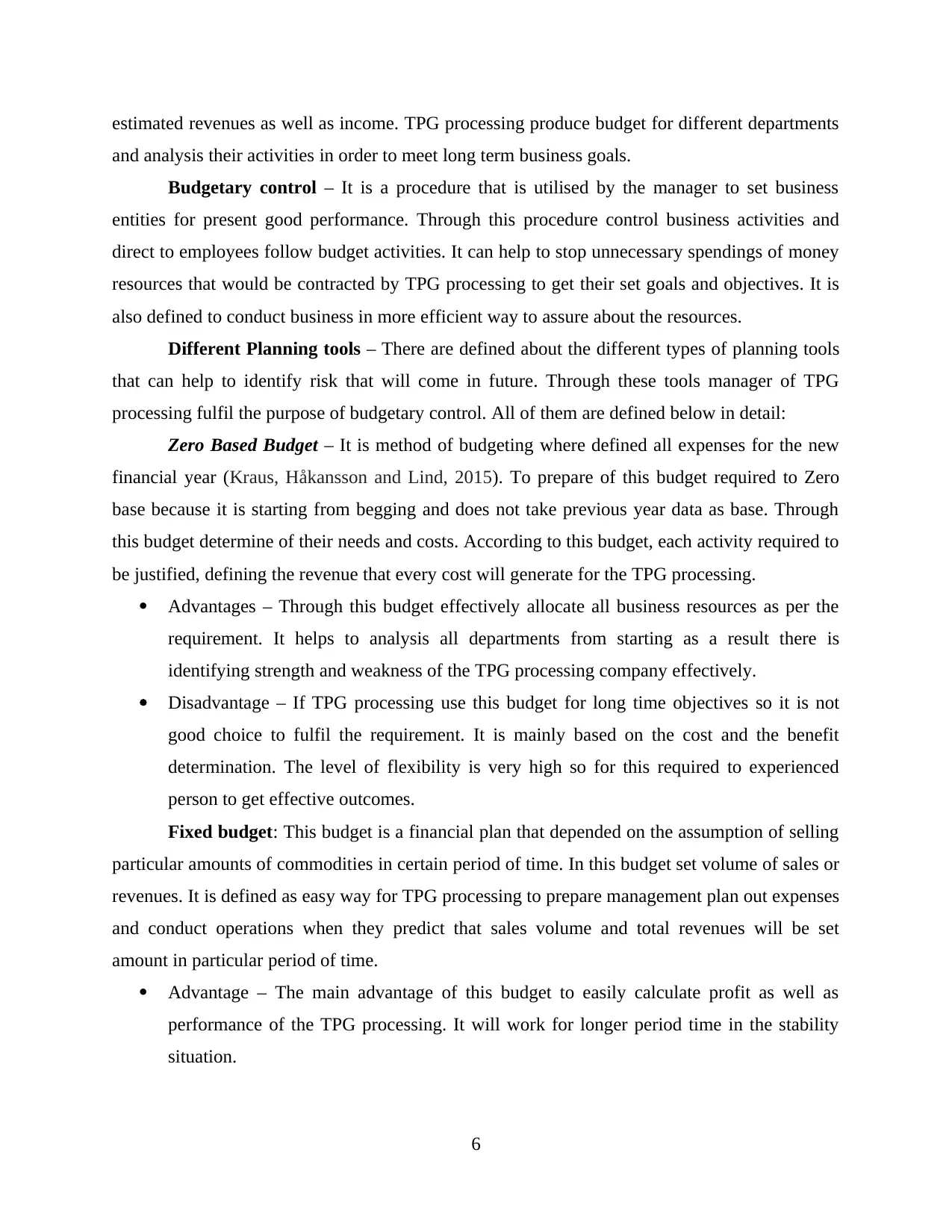
estimated revenues as well as income. TPG processing produce budget for different departments
and analysis their activities in order to meet long term business goals.
Budgetary control – It is a procedure that is utilised by the manager to set business
entities for present good performance. Through this procedure control business activities and
direct to employees follow budget activities. It can help to stop unnecessary spendings of money
resources that would be contracted by TPG processing to get their set goals and objectives. It is
also defined to conduct business in more efficient way to assure about the resources.
Different Planning tools – There are defined about the different types of planning tools
that can help to identify risk that will come in future. Through these tools manager of TPG
processing fulfil the purpose of budgetary control. All of them are defined below in detail:
Zero Based Budget – It is method of budgeting where defined all expenses for the new
financial year (Kraus, Håkansson and Lind, 2015). To prepare of this budget required to Zero
base because it is starting from begging and does not take previous year data as base. Through
this budget determine of their needs and costs. According to this budget, each activity required to
be justified, defining the revenue that every cost will generate for the TPG processing.
Advantages – Through this budget effectively allocate all business resources as per the
requirement. It helps to analysis all departments from starting as a result there is
identifying strength and weakness of the TPG processing company effectively.
Disadvantage – If TPG processing use this budget for long time objectives so it is not
good choice to fulfil the requirement. It is mainly based on the cost and the benefit
determination. The level of flexibility is very high so for this required to experienced
person to get effective outcomes.
Fixed budget: This budget is a financial plan that depended on the assumption of selling
particular amounts of commodities in certain period of time. In this budget set volume of sales or
revenues. It is defined as easy way for TPG processing to prepare management plan out expenses
and conduct operations when they predict that sales volume and total revenues will be set
amount in particular period of time.
Advantage – The main advantage of this budget to easily calculate profit as well as
performance of the TPG processing. It will work for longer period time in the stability
situation.
6
and analysis their activities in order to meet long term business goals.
Budgetary control – It is a procedure that is utilised by the manager to set business
entities for present good performance. Through this procedure control business activities and
direct to employees follow budget activities. It can help to stop unnecessary spendings of money
resources that would be contracted by TPG processing to get their set goals and objectives. It is
also defined to conduct business in more efficient way to assure about the resources.
Different Planning tools – There are defined about the different types of planning tools
that can help to identify risk that will come in future. Through these tools manager of TPG
processing fulfil the purpose of budgetary control. All of them are defined below in detail:
Zero Based Budget – It is method of budgeting where defined all expenses for the new
financial year (Kraus, Håkansson and Lind, 2015). To prepare of this budget required to Zero
base because it is starting from begging and does not take previous year data as base. Through
this budget determine of their needs and costs. According to this budget, each activity required to
be justified, defining the revenue that every cost will generate for the TPG processing.
Advantages – Through this budget effectively allocate all business resources as per the
requirement. It helps to analysis all departments from starting as a result there is
identifying strength and weakness of the TPG processing company effectively.
Disadvantage – If TPG processing use this budget for long time objectives so it is not
good choice to fulfil the requirement. It is mainly based on the cost and the benefit
determination. The level of flexibility is very high so for this required to experienced
person to get effective outcomes.
Fixed budget: This budget is a financial plan that depended on the assumption of selling
particular amounts of commodities in certain period of time. In this budget set volume of sales or
revenues. It is defined as easy way for TPG processing to prepare management plan out expenses
and conduct operations when they predict that sales volume and total revenues will be set
amount in particular period of time.
Advantage – The main advantage of this budget to easily calculate profit as well as
performance of the TPG processing. It will work for longer period time in the stability
situation.
6
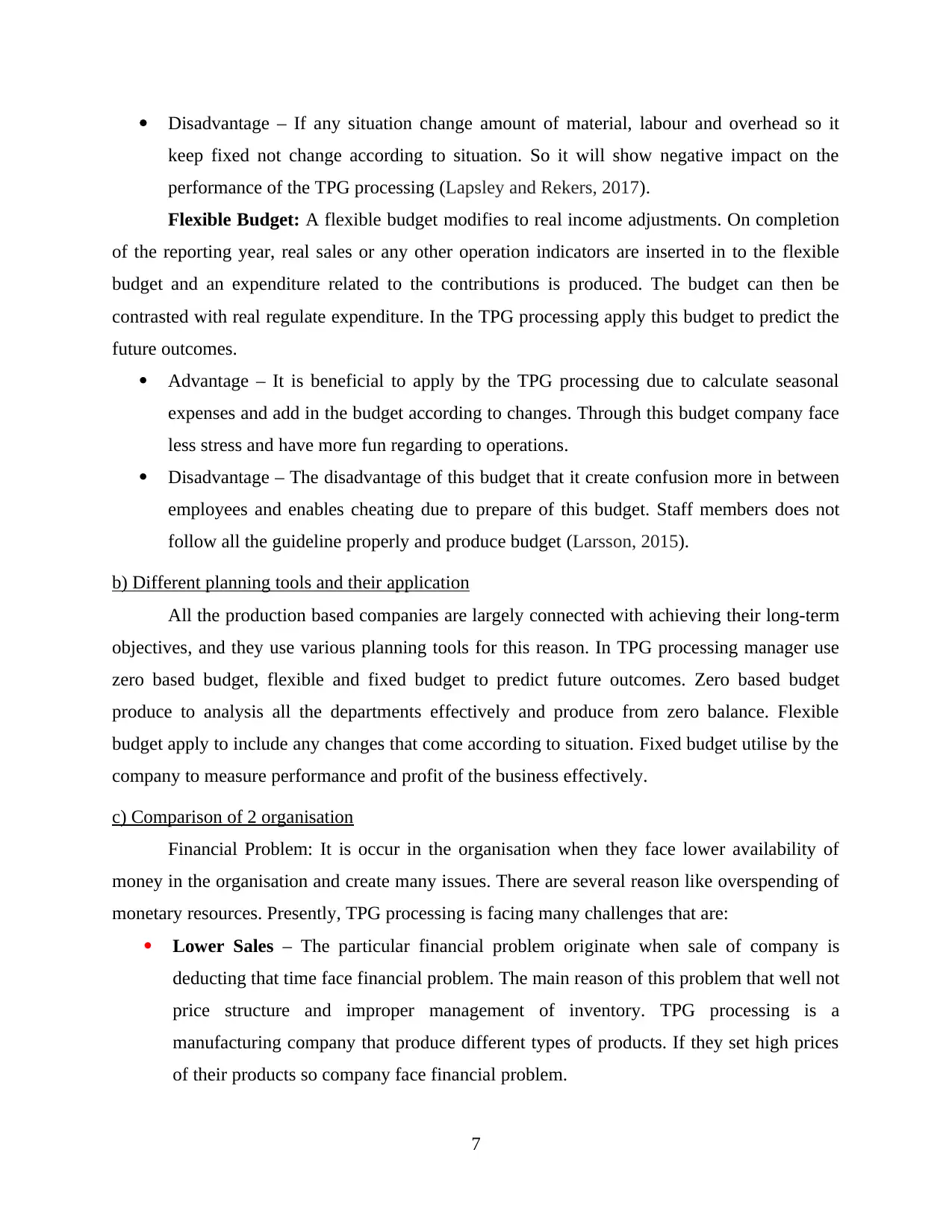
Disadvantage – If any situation change amount of material, labour and overhead so it
keep fixed not change according to situation. So it will show negative impact on the
performance of the TPG processing (Lapsley and Rekers, 2017).
Flexible Budget: A flexible budget modifies to real income adjustments. On completion
of the reporting year, real sales or any other operation indicators are inserted in to the flexible
budget and an expenditure related to the contributions is produced. The budget can then be
contrasted with real regulate expenditure. In the TPG processing apply this budget to predict the
future outcomes.
Advantage – It is beneficial to apply by the TPG processing due to calculate seasonal
expenses and add in the budget according to changes. Through this budget company face
less stress and have more fun regarding to operations.
Disadvantage – The disadvantage of this budget that it create confusion more in between
employees and enables cheating due to prepare of this budget. Staff members does not
follow all the guideline properly and produce budget (Larsson, 2015).
b) Different planning tools and their application
All the production based companies are largely connected with achieving their long-term
objectives, and they use various planning tools for this reason. In TPG processing manager use
zero based budget, flexible and fixed budget to predict future outcomes. Zero based budget
produce to analysis all the departments effectively and produce from zero balance. Flexible
budget apply to include any changes that come according to situation. Fixed budget utilise by the
company to measure performance and profit of the business effectively.
c) Comparison of 2 organisation
Financial Problem: It is occur in the organisation when they face lower availability of
money in the organisation and create many issues. There are several reason like overspending of
monetary resources. Presently, TPG processing is facing many challenges that are:
Lower Sales – The particular financial problem originate when sale of company is
deducting that time face financial problem. The main reason of this problem that well not
price structure and improper management of inventory. TPG processing is a
manufacturing company that produce different types of products. If they set high prices
of their products so company face financial problem.
7
keep fixed not change according to situation. So it will show negative impact on the
performance of the TPG processing (Lapsley and Rekers, 2017).
Flexible Budget: A flexible budget modifies to real income adjustments. On completion
of the reporting year, real sales or any other operation indicators are inserted in to the flexible
budget and an expenditure related to the contributions is produced. The budget can then be
contrasted with real regulate expenditure. In the TPG processing apply this budget to predict the
future outcomes.
Advantage – It is beneficial to apply by the TPG processing due to calculate seasonal
expenses and add in the budget according to changes. Through this budget company face
less stress and have more fun regarding to operations.
Disadvantage – The disadvantage of this budget that it create confusion more in between
employees and enables cheating due to prepare of this budget. Staff members does not
follow all the guideline properly and produce budget (Larsson, 2015).
b) Different planning tools and their application
All the production based companies are largely connected with achieving their long-term
objectives, and they use various planning tools for this reason. In TPG processing manager use
zero based budget, flexible and fixed budget to predict future outcomes. Zero based budget
produce to analysis all the departments effectively and produce from zero balance. Flexible
budget apply to include any changes that come according to situation. Fixed budget utilise by the
company to measure performance and profit of the business effectively.
c) Comparison of 2 organisation
Financial Problem: It is occur in the organisation when they face lower availability of
money in the organisation and create many issues. There are several reason like overspending of
monetary resources. Presently, TPG processing is facing many challenges that are:
Lower Sales – The particular financial problem originate when sale of company is
deducting that time face financial problem. The main reason of this problem that well not
price structure and improper management of inventory. TPG processing is a
manufacturing company that produce different types of products. If they set high prices
of their products so company face financial problem.
7
⊘ This is a preview!⊘
Do you want full access?
Subscribe today to unlock all pages.

Trusted by 1+ million students worldwide
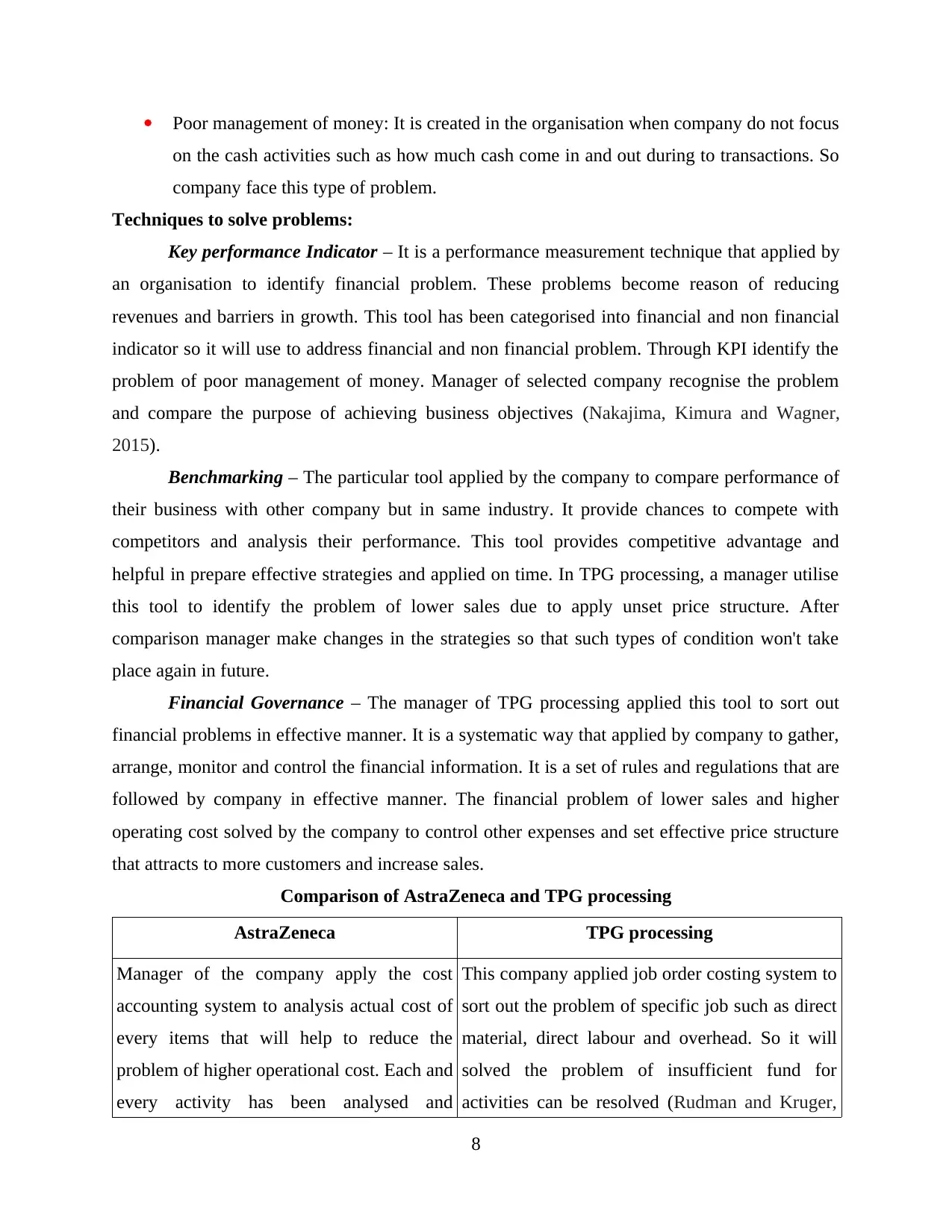
Poor management of money: It is created in the organisation when company do not focus
on the cash activities such as how much cash come in and out during to transactions. So
company face this type of problem.
Techniques to solve problems:
Key performance Indicator – It is a performance measurement technique that applied by
an organisation to identify financial problem. These problems become reason of reducing
revenues and barriers in growth. This tool has been categorised into financial and non financial
indicator so it will use to address financial and non financial problem. Through KPI identify the
problem of poor management of money. Manager of selected company recognise the problem
and compare the purpose of achieving business objectives (Nakajima, Kimura and Wagner,
2015).
Benchmarking – The particular tool applied by the company to compare performance of
their business with other company but in same industry. It provide chances to compete with
competitors and analysis their performance. This tool provides competitive advantage and
helpful in prepare effective strategies and applied on time. In TPG processing, a manager utilise
this tool to identify the problem of lower sales due to apply unset price structure. After
comparison manager make changes in the strategies so that such types of condition won't take
place again in future.
Financial Governance – The manager of TPG processing applied this tool to sort out
financial problems in effective manner. It is a systematic way that applied by company to gather,
arrange, monitor and control the financial information. It is a set of rules and regulations that are
followed by company in effective manner. The financial problem of lower sales and higher
operating cost solved by the company to control other expenses and set effective price structure
that attracts to more customers and increase sales.
Comparison of AstraZeneca and TPG processing
AstraZeneca TPG processing
Manager of the company apply the cost
accounting system to analysis actual cost of
every items that will help to reduce the
problem of higher operational cost. Each and
every activity has been analysed and
This company applied job order costing system to
sort out the problem of specific job such as direct
material, direct labour and overhead. So it will
solved the problem of insufficient fund for
activities can be resolved (Rudman and Kruger,
8
on the cash activities such as how much cash come in and out during to transactions. So
company face this type of problem.
Techniques to solve problems:
Key performance Indicator – It is a performance measurement technique that applied by
an organisation to identify financial problem. These problems become reason of reducing
revenues and barriers in growth. This tool has been categorised into financial and non financial
indicator so it will use to address financial and non financial problem. Through KPI identify the
problem of poor management of money. Manager of selected company recognise the problem
and compare the purpose of achieving business objectives (Nakajima, Kimura and Wagner,
2015).
Benchmarking – The particular tool applied by the company to compare performance of
their business with other company but in same industry. It provide chances to compete with
competitors and analysis their performance. This tool provides competitive advantage and
helpful in prepare effective strategies and applied on time. In TPG processing, a manager utilise
this tool to identify the problem of lower sales due to apply unset price structure. After
comparison manager make changes in the strategies so that such types of condition won't take
place again in future.
Financial Governance – The manager of TPG processing applied this tool to sort out
financial problems in effective manner. It is a systematic way that applied by company to gather,
arrange, monitor and control the financial information. It is a set of rules and regulations that are
followed by company in effective manner. The financial problem of lower sales and higher
operating cost solved by the company to control other expenses and set effective price structure
that attracts to more customers and increase sales.
Comparison of AstraZeneca and TPG processing
AstraZeneca TPG processing
Manager of the company apply the cost
accounting system to analysis actual cost of
every items that will help to reduce the
problem of higher operational cost. Each and
every activity has been analysed and
This company applied job order costing system to
sort out the problem of specific job such as direct
material, direct labour and overhead. So it will
solved the problem of insufficient fund for
activities can be resolved (Rudman and Kruger,
8
Paraphrase This Document
Need a fresh take? Get an instant paraphrase of this document with our AI Paraphraser
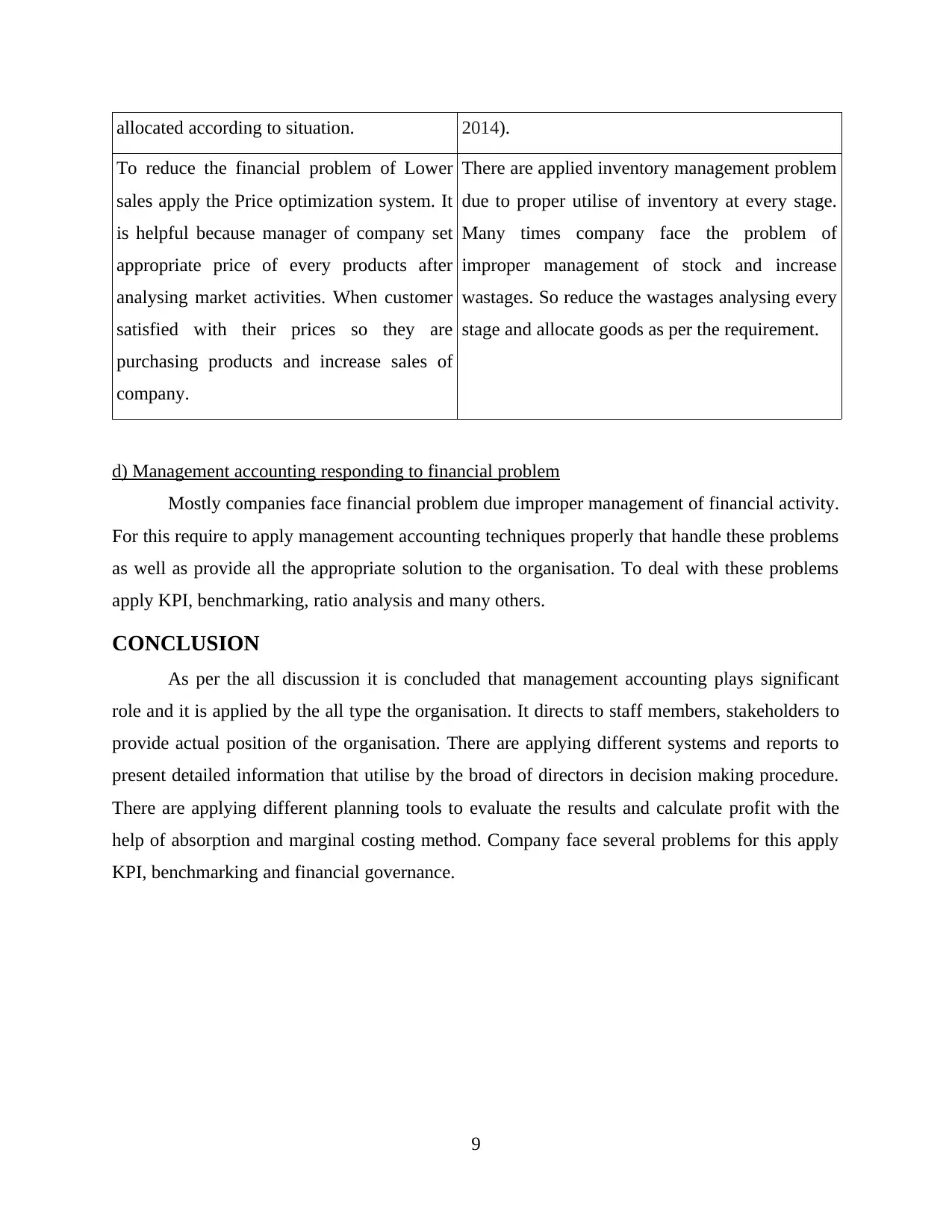
allocated according to situation. 2014).
To reduce the financial problem of Lower
sales apply the Price optimization system. It
is helpful because manager of company set
appropriate price of every products after
analysing market activities. When customer
satisfied with their prices so they are
purchasing products and increase sales of
company.
There are applied inventory management problem
due to proper utilise of inventory at every stage.
Many times company face the problem of
improper management of stock and increase
wastages. So reduce the wastages analysing every
stage and allocate goods as per the requirement.
d) Management accounting responding to financial problem
Mostly companies face financial problem due improper management of financial activity.
For this require to apply management accounting techniques properly that handle these problems
as well as provide all the appropriate solution to the organisation. To deal with these problems
apply KPI, benchmarking, ratio analysis and many others.
CONCLUSION
As per the all discussion it is concluded that management accounting plays significant
role and it is applied by the all type the organisation. It directs to staff members, stakeholders to
provide actual position of the organisation. There are applying different systems and reports to
present detailed information that utilise by the broad of directors in decision making procedure.
There are applying different planning tools to evaluate the results and calculate profit with the
help of absorption and marginal costing method. Company face several problems for this apply
KPI, benchmarking and financial governance.
9
To reduce the financial problem of Lower
sales apply the Price optimization system. It
is helpful because manager of company set
appropriate price of every products after
analysing market activities. When customer
satisfied with their prices so they are
purchasing products and increase sales of
company.
There are applied inventory management problem
due to proper utilise of inventory at every stage.
Many times company face the problem of
improper management of stock and increase
wastages. So reduce the wastages analysing every
stage and allocate goods as per the requirement.
d) Management accounting responding to financial problem
Mostly companies face financial problem due improper management of financial activity.
For this require to apply management accounting techniques properly that handle these problems
as well as provide all the appropriate solution to the organisation. To deal with these problems
apply KPI, benchmarking, ratio analysis and many others.
CONCLUSION
As per the all discussion it is concluded that management accounting plays significant
role and it is applied by the all type the organisation. It directs to staff members, stakeholders to
provide actual position of the organisation. There are applying different systems and reports to
present detailed information that utilise by the broad of directors in decision making procedure.
There are applying different planning tools to evaluate the results and calculate profit with the
help of absorption and marginal costing method. Company face several problems for this apply
KPI, benchmarking and financial governance.
9
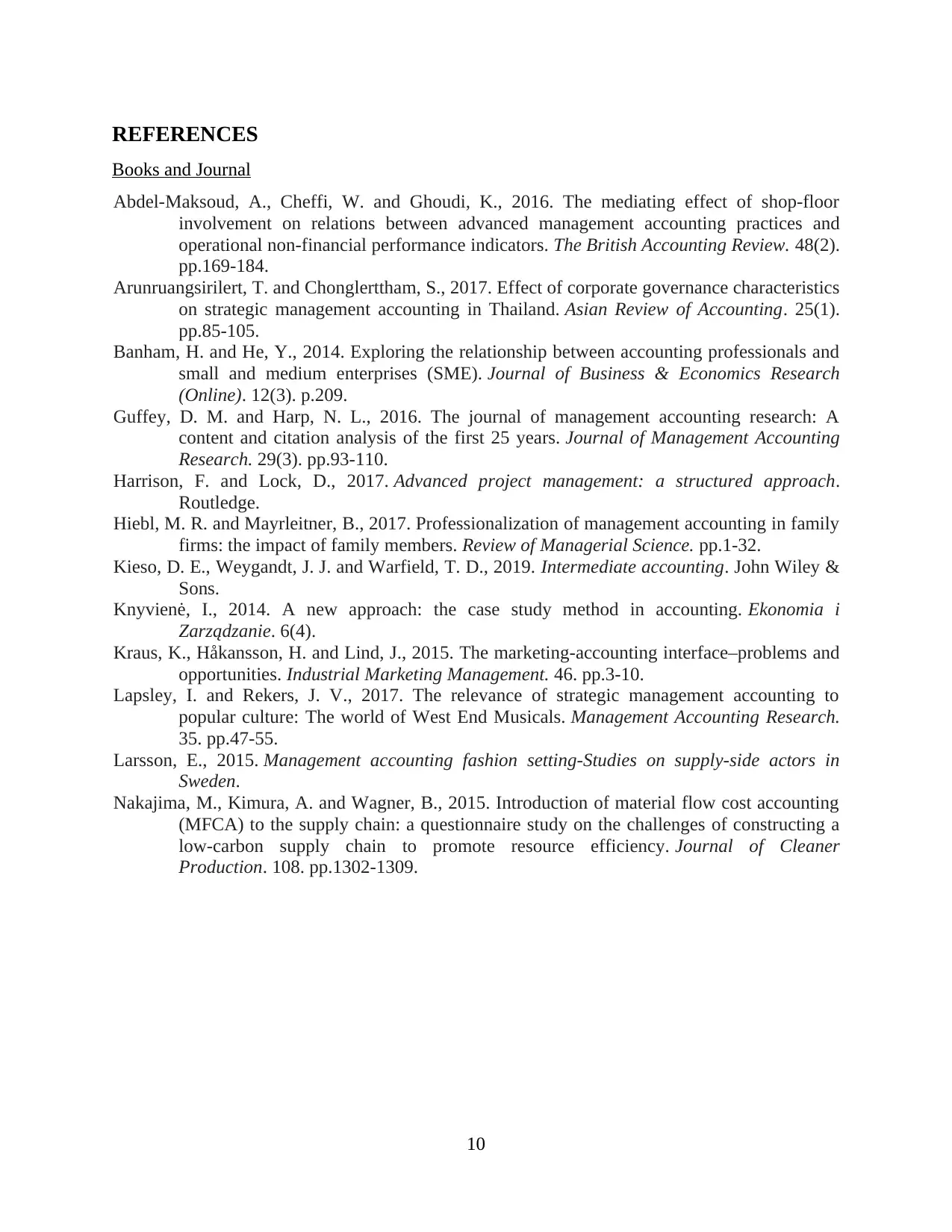
REFERENCES
Books and Journal
Abdel-Maksoud, A., Cheffi, W. and Ghoudi, K., 2016. The mediating effect of shop-floor
involvement on relations between advanced management accounting practices and
operational non-financial performance indicators. The British Accounting Review. 48(2).
pp.169-184.
Arunruangsirilert, T. and Chonglerttham, S., 2017. Effect of corporate governance characteristics
on strategic management accounting in Thailand. Asian Review of Accounting. 25(1).
pp.85-105.
Banham, H. and He, Y., 2014. Exploring the relationship between accounting professionals and
small and medium enterprises (SME). Journal of Business & Economics Research
(Online). 12(3). p.209.
Guffey, D. M. and Harp, N. L., 2016. The journal of management accounting research: A
content and citation analysis of the first 25 years. Journal of Management Accounting
Research. 29(3). pp.93-110.
Harrison, F. and Lock, D., 2017. Advanced project management: a structured approach.
Routledge.
Hiebl, M. R. and Mayrleitner, B., 2017. Professionalization of management accounting in family
firms: the impact of family members. Review of Managerial Science. pp.1-32.
Kieso, D. E., Weygandt, J. J. and Warfield, T. D., 2019. Intermediate accounting. John Wiley &
Sons.
Knyvienė, I., 2014. A new approach: the case study method in accounting. Ekonomia i
Zarządzanie. 6(4).
Kraus, K., Håkansson, H. and Lind, J., 2015. The marketing-accounting interface–problems and
opportunities. Industrial Marketing Management. 46. pp.3-10.
Lapsley, I. and Rekers, J. V., 2017. The relevance of strategic management accounting to
popular culture: The world of West End Musicals. Management Accounting Research.
35. pp.47-55.
Larsson, E., 2015. Management accounting fashion setting-Studies on supply-side actors in
Sweden.
Nakajima, M., Kimura, A. and Wagner, B., 2015. Introduction of material flow cost accounting
(MFCA) to the supply chain: a questionnaire study on the challenges of constructing a
low-carbon supply chain to promote resource efficiency. Journal of Cleaner
Production. 108. pp.1302-1309.
10
Books and Journal
Abdel-Maksoud, A., Cheffi, W. and Ghoudi, K., 2016. The mediating effect of shop-floor
involvement on relations between advanced management accounting practices and
operational non-financial performance indicators. The British Accounting Review. 48(2).
pp.169-184.
Arunruangsirilert, T. and Chonglerttham, S., 2017. Effect of corporate governance characteristics
on strategic management accounting in Thailand. Asian Review of Accounting. 25(1).
pp.85-105.
Banham, H. and He, Y., 2014. Exploring the relationship between accounting professionals and
small and medium enterprises (SME). Journal of Business & Economics Research
(Online). 12(3). p.209.
Guffey, D. M. and Harp, N. L., 2016. The journal of management accounting research: A
content and citation analysis of the first 25 years. Journal of Management Accounting
Research. 29(3). pp.93-110.
Harrison, F. and Lock, D., 2017. Advanced project management: a structured approach.
Routledge.
Hiebl, M. R. and Mayrleitner, B., 2017. Professionalization of management accounting in family
firms: the impact of family members. Review of Managerial Science. pp.1-32.
Kieso, D. E., Weygandt, J. J. and Warfield, T. D., 2019. Intermediate accounting. John Wiley &
Sons.
Knyvienė, I., 2014. A new approach: the case study method in accounting. Ekonomia i
Zarządzanie. 6(4).
Kraus, K., Håkansson, H. and Lind, J., 2015. The marketing-accounting interface–problems and
opportunities. Industrial Marketing Management. 46. pp.3-10.
Lapsley, I. and Rekers, J. V., 2017. The relevance of strategic management accounting to
popular culture: The world of West End Musicals. Management Accounting Research.
35. pp.47-55.
Larsson, E., 2015. Management accounting fashion setting-Studies on supply-side actors in
Sweden.
Nakajima, M., Kimura, A. and Wagner, B., 2015. Introduction of material flow cost accounting
(MFCA) to the supply chain: a questionnaire study on the challenges of constructing a
low-carbon supply chain to promote resource efficiency. Journal of Cleaner
Production. 108. pp.1302-1309.
10
⊘ This is a preview!⊘
Do you want full access?
Subscribe today to unlock all pages.

Trusted by 1+ million students worldwide
1 out of 20
Related Documents
Your All-in-One AI-Powered Toolkit for Academic Success.
+13062052269
info@desklib.com
Available 24*7 on WhatsApp / Email
![[object Object]](/_next/static/media/star-bottom.7253800d.svg)
Unlock your academic potential
Copyright © 2020–2025 A2Z Services. All Rights Reserved. Developed and managed by ZUCOL.





